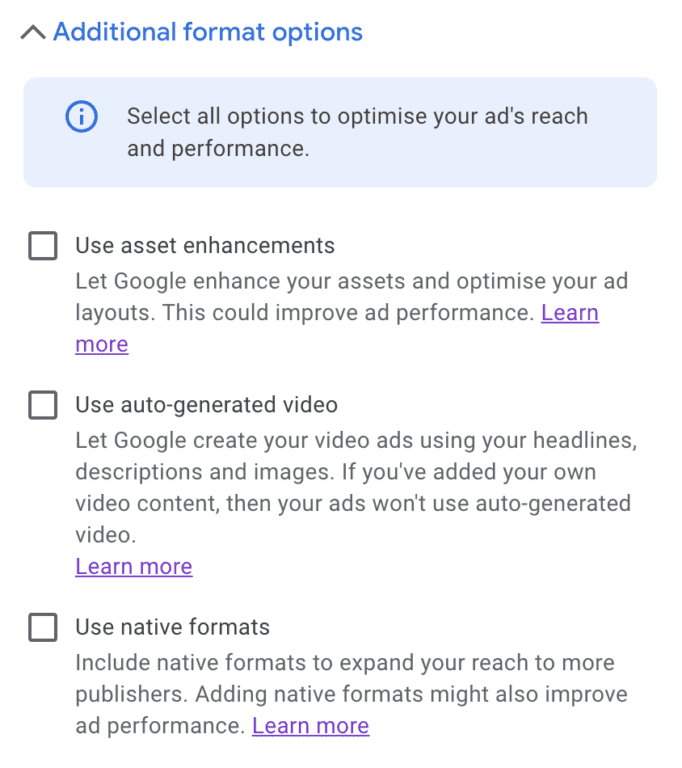
Abby Webb
Head of Search & Content
Abby heads up our SEO and content campaigns, with a strong background in copywriting, content and paid search marketing.

Google Ads now uses generative AI to create text, images and video for ad campaigns. Here’s what it can do, and its limits.
AI has taken the world of digital marketing by storm.
We’ve seen AI being used in Google Analytics, it’s changing the way we approach content marketing and what we post on social media. Now, it’s the turn of Google Ads. The platform already includes a range of AI features and, at Google Marketing Live, recently shared its plans for an AI-focused future.
In its promise to help advertisers “find new customers, unlock additional performance opportunities, and accelerate your business growth”, the tech giant announced that it will soon be introducing new AI-powered advertising solutions, including generative AI, where users can provide content (copy, images, videos) and Google Ads will “remix” the information to generate unique ads.
Here, I share what Google Ads’ AI-powered features can do – and where its limitations lie.
As I already mentioned, Google Ads has used AI in a limited capacity for a while now. It uses AI to automatically create ad extensions, like this example of sitelinks created by Google here:

Here’s where AI runs into issues, however. When it tries to create its own copy, that copy can sound generic or even nonsensical as it attempts to use landing page copy in the sitelink description:

“Select Your Preferred Category To Know About Our Career” isn’t going to get many clicks. Even when Google Ads’ generative AI creates an asset which makes sense, there’s another problem.
To get value for money from your Google Ads campaign, your ads should focus on a single audience, with the aim of realising a single goal. Google Ads’ generative AI isn’t great at creating copy that targets specific audiences and goals – although this is Google’s long-term aim. For now, however, Google Ads isn’t always able to generate convincing or useful copy that will get you the results you’re looking for.
However, in Google Marketing Live, Google announced the development of a new “conversational experience” tool. The “conversational experience” tool will allow advertisers to – in a similar way we’re familiar with prompting ChatGPT – provide the details Google Ads needs to generate headlines and descriptions for responsive search ads.
Google Ads’ AI isn’t just about generating text, however. In responsive display ads, Google can also use AI for asset enhancement and video creation from your headlines and images. You can select these additional options in this drop-down menu:

These options allow google to crop, enhance and add overlay copy using a combination of your supplied assets. In most cases, this can work well – particularly the asset enhancement feature – but it’s always worth previewing AI-created ads before launch to check that everything you need included in your ads are still there. However, the videos auto-generated aren’t the most creative as they are essentially a slideshow of your images, so it’s much better to create your own video content if you can rather than relying on Google’s AI abilities here.
In future, Google will be introducing new tools to help with asset creation, although these are more likely to benefit eCommerce advertisers. This includes the “Product Studio”, which will help advertisers generate product images for their Shopping and Performance Max ads.
Although there might be some way to go with the AI creative tools on Google Ads, let’s not forget how AI and machine learning have already made their mark on the platform. Smart bidding and responsive ad formats have become go-to features in the past few years, which have both made the ads landscape feel much more dynamic as they automatically change bids or the ad format in an attempt to improve ad performance.
I’m excited to see how AI will impact and enhance the ad creation experience, just as its changing the way we analyse data and plan our campaign activities.
Got any questions? Email me at [email protected].

Head of Search & Content
Abby heads up our SEO and content campaigns, with a strong background in copywriting, content and paid search marketing.
View my other articles and opinion pieces below
Google’s AI search demands higher standards for YMYL content. Learn how to keep your financial, legal or health advice visible, trusted and compliant.

At Google Marketing Live 2025, the focus was clear: AI is already changing the way people search, and as a result, it’s changing what brands need to do to show up in search results. Here’s what you need to know – and what it means for your marketing.

Love it or hate it, everyone’s seen it. Google’s AI Overviews are changing the way your search results appear. Now, AI-generated summaries will often answer user questions before the usual list of site links we’ve come to expect. In fact, 47% of Google Search results now include an AI Overview – at least, according to AI […]

This short guide will teach you how to track your marketing campaigns using UTM parameters. Also referred to as a custom URL, a UTM tag is a customised snippet of text (called a parameter) that is added at the end of a website address. This UTM tag allows you to track and identify the traffic […]
